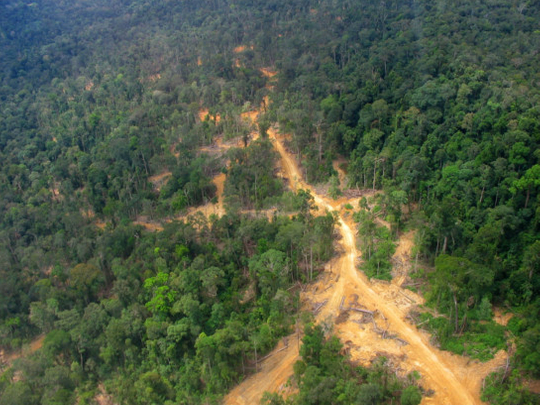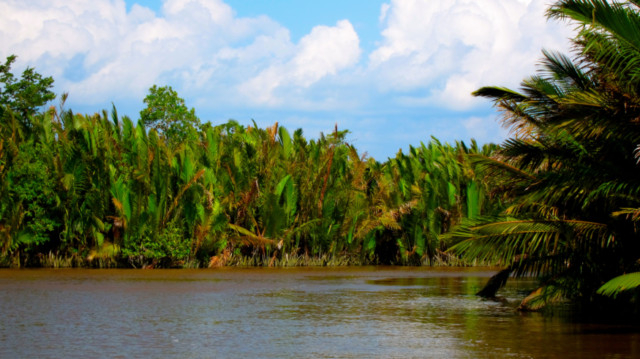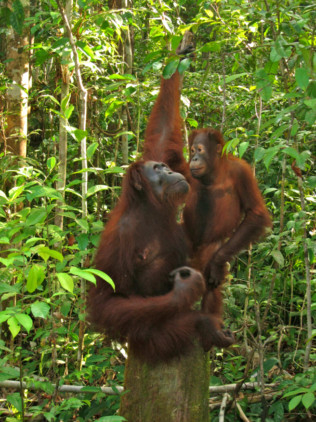
The world’s forests are disappearing at the rate of one football-pitch per second and flying in over Indonesian Borneo (Kalimantan), the numerous plumes of smoke, leaving their blackened scars on the patchwork quilt of felled trees and naked land below, are testament to that fact.
Once an area of prolific tropical rainforests, almost half of Indonesia’s 22.5 million hectares of peatland have already been deforested and drained — ecologically rich terrain replaced by endless regimented rows of nutrient sapping palm oil.
In 2008 the Guinness Book of Records gave Indonesia the dubious accolade of the country with the fastest rate of deforestation, caused by legal and illegal logging, forest fires, mining, settlements, slash-and-burn farming methods, road mapping and the huge expansion of palm oil plantations.
A problem that is particularly prolific on the island of Kalimantan, the third largest island in the world, where in recent years some six million hectares (roughly six million rugby pitches) of rainforest have been destroyed, primarily to make way for the misguided panacea to Indonesia’s social woes: palm oil.
Seen as a driver to ease small-scale farmers out of the poverty cycle and ultimately boost Indonesia’s economy, the oil that can be found in every other supermarket product, from popular chocolates and family-favourite cereals to common soaps and trendy cosmetics, is now heavily linked to highly unsustainable deforestation, and decimation of some of the world’s most threatened species, including the highly intelligent Orangutan.
“The effect of palm oil on the orangutan population is devastating,” says Marie Gale from Save Indonesian Endangered Species (SIES), “and it’s not just the orangutans, it’s the loss of forest, the loss of biodiversity, and ultimately the loss of all the species, such as monkeys, sun bears, leopards, and birds. Their habitat is being encroached and consequently they are being forced to cohabit in a very small environment.”
Native solely to Indonesia and Malaysia, orangutans are now only found in the rainforests of Borneo and Sumatra, where satellite images show that they have lost as much as 80 per cent of their natural habitat over the past two decades. It is estimated that there are about 40,000 orangutans remaining on the two Indonesian islands, down from 230,000 throughout Southeast Asia a century ago.
The species has come under serious threat of extinction due to innumerable reasons, from poaching and habitat destruction to the illegal pet trade. However, the surging global demand for palm oil and the consequent degradation of the rainforest is proving, by far, to be the most destructive.
Palm oil — a household name
Capable of producing up to ten times more oil than any other crop, oil palm has sparked a boom in the country’s economy. The oil that uniquely remains solid at room temperature is an invaluable ingredient in up to 50 per cent of consumer goods, primarily processed foods. However, more recently, it has gained even more popularity as a “green” biofuel.
Its versatility dictates its acceptance and as much as 50 million tonnes are now produced each year for the world market, with Indonesia and Malaysia accounting for 90 per cent of this production.
With global consumption expected to rise more than 30 per cent in the next decade, it comes as no surprise that Indonesia’s government plans to increase production to 40 million tonnes by 2020 — good news for the economy, bad news for orangutans and their habitat.
“We need to be careful not to make people scared to consume palm oil, though,” explains Bustar Maitar, head of Indonesian Forestry Campaign for Greenpeace. “We don’t want to position it as a bad product because it has a key role to play in terms of Indonesia’s economic development but we need to challenge companies to adopt a zero deforestation policy to produce sustainable palm oil.”
Kalimantan has about ten million hectares of palm plantations today and as next year’s elections loom, more concessions are being handed out by local officials at alarming rates.
“On one side, the government’s efforts to fulfil democracy by giving authority to district and provincial levels is good,” explains Maitar, “but it [palm oil] is also the cause of decentralisation and now, as elections approach, our experience shows that in order to get quick support from powerful businessmen, there is an increase in the amount of forest areas that are given away for concessions … The natural-resources sector, especially forests, is like an ATM machine for the political parties and this is something that needs to be stopped.”
Most recently, a decree was issued allowing a slice of Tanjung Puting National Park in central Kalimantan, the largest protected area of tropical heath and peat swamp forest in Southeast Asia, to be cleared for palm oil by a local company BGA (through its subsidiary PT Andalan Sukses Makmur — PT ASM). Another 12,000 hectares, where environmentalists have been planting saplings in an attempt at reforestation, is to be cleared.
Officials say it is providing thousands of poor Indonesians with income and employment, but NGOs complain that too many companies do not follow the law or codes of practice. “There are rules and regulations in place and they are supposed to carry out environmental assessments,” says SIES’s Gale, “but when they looked at this latest concession, they didn’t find anything of concern. The plantation companies are also supposed to get a permit to start excavation but they have already started excavating and we still haven’t seen that permit.”
Deforestation
These are fruit-rich lowland areas close to rivers and peat swamp forests, environments that are favoured both by orangutans but also by palm-oil companies. For the palm oil to grow effectively in the tropics soil, however, farmers must use slash-and-burn techniques, salvaging the available timber before setting the remaining scrub on fire to clear the land for seedlings.
Often the burning is uncontrolled, spreading to neighbouring forest and in the dry months of June to September, when most farmers carry out land clearing, major fire outbreaks are not uncommon. The WWF (World Wildlife Fund) has used satellite images to prove that commercial development, especially palm plantations, was the largest single cause of the 1997-98 fire, a blaze that destroyed some 9.7 million hectares of land, causing damages worth more than $9 billion and killing more than 8,000 Bornean orangutans.
This year, the prolonged El Nino meant fires engulfed Sumatra and east Kalimantan for nine months, and smoke was a hazard as far away as Singapore and Malaysia. Indonesia’s president was forced to apologise after the fires led to Singapore’s worst environmental crisis in ten years and forced 200 schools to close in Malaysia.
Many studies indicate that oil palm expansion is partly responsible for wildfires, Lisa Curran, project leader of a Stanford and Yale universities-led study, said in a press release, “These plantation leases are an unprecedented ‘grand-scale experiment’ replacing forests with exotic palm monocultures. We may see tipping points in forest conversion where critical biophysical functions are disrupted, leaving the region increasingly vulnerable to droughts, fires, and floods.”
It is a disturbing forecast given this year alone saw thousands of hectares of biodiversity destroyed through deforestation, consequently releasing unparalleled amounts of CO2 (carbon dioxide) emissions. Perhaps this is why Indonesia is the third largest emitter of greenhouses gases in the world, after the United States and China.
Knock-on effects
The irresponsible slash-and-burn farming in the pursuit of profits not only decimates vast swaths of forest leading to environmental damage, but razes the natural habitat of orangutans.
As their rainforest home is destroyed, the arboreal creatures have no more trees on which they can travel, and so are forced to escape burning land by foot. Not being natural ground travellers, they are often too slow for the flames and are ultimately burnt to death.
Those that survive find they have nowhere left to go, and are forced into narrow corridors of forest with limited amount of food. Consequently, they are drawn to raid crops and village gardens.
The past few years have seen several headlines involving palm-oil workers hunting down orangutans, now seen as pests in farmland. Some conservationists have reports of the large apes being hacked to death with machetes, while others have been gunned down, or fatally beaten.
“About 1 kilometre inland from the Sekonyer River, the palm oil plantations begin,” explains Basuki Santoso, general manager of the Friends of the National Parks Foundation (FNPF). “There are so many orangutans in this small area of land and because there is not enough room for them, they go to the palm oil plantations where they are often shot and killed. Now even this small area of land they had left has just been given away for more palm oil.”
The plantations not only destroy their homes, forcing them into small isolated patches of remaining rainforest, but also deplete their food stocks. Often the great apes are found emaciated, on the brink of starvation.
Earlier this year, the Indonesian arm of the charity International Animal Rescue (IAR) saved four starving orangutans from an oil palm plantation — belonging to a company that is a member of the Roundtable on Sustainable Palm Oil (RSPO).
Karmele Llano Sanchez, executive director of IAR Indonesia, said in a press release: “We were appalled at the condition of these orangutans. All of them had gone through long periods of starvation before we rescued them. The area where they were found, since the company had cleared most of the forest, was too small to provide them with sufficient food.”
The IAR, which then airlifted the starving primates to an area of forest with enough food, discovered that despite laws preventing palm oil concessions that deprive orangutans and other endangered species of their habitat and food, the orangutans had been forced into eating tree bark because there were so little leaves available.
Images of a lone orangutan hanging to a single tree left in hectares of bulldozed land had conservationists crying out and the IAR urged the company, Bumitama Gunajaya Agro (BGA), to stop any more intended land clearing on the borders of the Gunung Palung National Park, an area which is home to one of the largest populations of Bornean orangutans.
Although this time the starving orangutans were brought to the attention of the IAR by the palm oil managers, it is rumoured many are killed before a handful are reported, while often it is the mothers that are killed so their offspring can be sold illegally as pets.
According to the WWF, studies have indicated that 200 to 500 orangutans from Indonesian Borneo alone enter the pet trade each year. With each carrying a price tag of as much as $30,000 (Dh110,189), it is lucrative business. Naturally, due to poor care and hygiene, injury from falling from trees after their mother is shot, or the trauma of seeing their mother killed, most baby orangutans do not survive their first year, and it is believed that for every orangutan that does survive, six to eight would have died.
In the palm of their hands
Despite laws designed to protect the species, much of the struggle seems to depend on charities and volunteer conservationists. But despite best efforts, the hands of many charitable organisations are tied.
Palm oil has pushed up the price of local land and now, any charity wishing to buy land for reforestation purposes is faced with prices of between $500 and $1000 a hectare — an unfeasible sum for small-scale conservationists.
Others find that land they have worked hard to reforest has fallen prey to concessions. “Friends of the National Parks Foundation, together with the local community, have planted 150,000 rainforest trees across a 300-hectare area that was previously within the National Park boundaries,” Gale explains.
“After years of hard work, collecting seedlings, raising them and then replanting, they are devastated that all their hard work to create urgently needed forest for orangutans, monkeys, sunbears and others is about to be bulldozed for palm oil.”
Charities forced into a corner are, therefore, focusing efforts on dissuading villagers from plantation employment. With 44 per cent of central Kalimantan’s population relying directly on palm oil for their livelihoods, it is not easy. Many villagers will agree to cultivate their land with the promise of $3,000 yields. However, what they fail to understand is that the benefits are short-term, that oil palm plants only have a 25-year lifespan, and many villagers end up getting themselves into a debt cycle with the companies.
“PT Bumitama Agri, who are responsible for the expansion of palm oil into the Tanjung Puting National Park and the sensitive buffer zone, have focused on getting local villagers to support them with the lure of easy money,” Gale says. “Sadly, experiences elsewhere show that these are hollow promises.”
SIES, along with FNPF, is, therefore, trying to educate communities and provide villagers with alternative viable income sources. Their focus is on providing financial security to the residents and protecting their land from takeover through eco-tourism, agroforestry and organic farming.
Recently they funded a community cattle and organic produce farm providing cows to those villagers who opted not to work with the palm oil industry. It is an all-round approach.
“We can’t protect the area if the people aren’t safe,” says Santoso, “so we must give them education and income. We don’t just talk about orangutans and reforestation; we have to take care of all the aspects to teach people about conserving our land.”
Sustainable palm oil?
Although conservationists are doing their best to protect the area, efforts are also being made to try and regulate the high-street palm oil industry at national governance level. RSPO was set up in 2001 with the aim of creating a body that could set criteria for greener palm oil production. However, despite its formation, forest destruction has continued unabated.
“Ostensibly they are all under an umbrella to follow sustainable practice,” Gale says. “They aren’t allowed to cultivate palm oil in national parks. They can’t cut down high-conservation forest or destroy wildlife. However the RSPO needs to enforce its Principles and Criteria (2013), particularly the criteria, to conserve biodiversity and comply with laws.”
A recent report by Greenpeace, “Certifying Destruction”, revealed that a few of the RSPO members were flagrantly flouting laws by continuing to buy or trade palm oil produced via the conversion of rainforests and carbon-dense peatlands.
“A lot of [RSPO] members are actively carrying out deforestation,” says Greenpeace’s Maitar, “which is ironic as they are meant to be complying with standards when they expand their plantations. Becoming a member for some is just a PR exercise, and one of our biggest challenges is how to change that behaviour.”
Another key move in conservation efforts was brokered in 2011 by the Indonesia-Norway $1 billion REDD deal, under which Norway promised to pay Indonesia $1 billion to protect its remaining rainforests and peatlands. Central Kalimantan became the pilot province, with President Susilo Bambang Yudhoyono placing a two-year moratorium on new logging permits. However, the loophole was that the deal did not apply to existing concessions, only virgin rainforest. Norway has so far only handed over a small sum of the pledged money, as it was a performance-based deal.
Consumers
Apart from the big players, orangutans are ultimately at the mercy of uninformed consumers. Palm oil is a consumer-driven problem and raising awareness among the everyday shoppers is key.
Today, the majority of consumers have no idea that their washing liquid, hand soap, favourite cookies and breakfast cereals contain such an environmentally damaging product. “The supply chain is very complex,” Gale says. “It goes to a very broad market — of soaps and shampoos — but there are no labelling laws yet … There needs to be clear labelling in all products so that consumers throughout the world can make informed choices about purchases.”
At present, producers are able to group oils under the one umbrella term “vegetable oil”, but thanks to the constant efforts of conservationists, from December 2014 onwards, food producers will be obliged to mention palm oil, giving customers the choice that the orangutans do not have.
It seems the small drops are finally making an ocean and the world’s attention is being drawn. As Maitar says, “We are challenging the market to have strong policies on no deforestation and a couple of big corporations have made this happen. Nestlé and Unilever have now committed to sourcing palm oil responsibly produced by companies. If they can make that commitment, other companies can do the same.”




